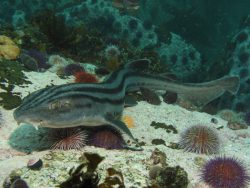select your film:


Pyjama Catsharks, also known as striped catsharks, are found off the coast of South Africa in the southeast Atlantic Ocean and the western Indian Ocean at depths up to 100 m.
Biology and Behaviour
This slow-swimming catshark is distinguished most by its long horizontal black stripes along its back.
Similar to leopard catsharks, pyjama catsharks also favour caves and crevices on rocky reefs and kelp beds. They are more active at hung, but will also feed during the day. They prey on cephalopods, crustaceans, bony fish, hagfishes, small batons, bivalves and bristle worms.
Reproduction and Lifespan
Pyjama catsharks are oviparous and females produce two eggs at a time. When the young ones hatch, they are 14 to 15 cm in length. Male pyjama sharks are adolescent at 78 to 81 cm long and adult males are between 75 to 91 cm long. Female pyjama sharks are adolescent at 79 to 83 cm in length and are adults between 75 to 93 cm long. They can grow up to 101 cm long.
Conservation and Tourism
The IUCN lists pyjama catsharks as near threatened, but there are no conservation methods currently in place. However, the South African Sea Fisheries Research Institute is considering to decommercialize the pyjama catshark and the leopard catshark.
Pyjama catsharks are also popular in the aquarium trade because of its small size and the striped pattern on its back.
Do you have images or videos of Pyjama Catsharks?
Submit them to [email protected].
